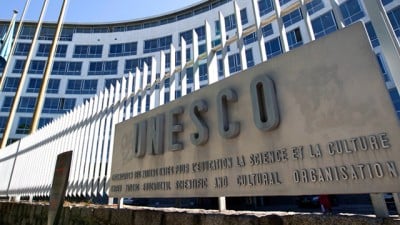Climate Change Censorship: Australia and UNESCO

Censoring climate change and its reporting is a big business, notably among fossil fuel obsessives and those in denial. It continues to fulfil a role in the policies of Australia’s Turnbull government. Even after the demise of Tony Abbott last year, his successor continues to scrub his own environmental credentials from his profile. As he does so, an assortment of weasel words have found their way into the political argot: “innovation”, “growth” and a host of other empty treats.
Despite lauding various efforts to pursue “clean energy” (PM Malcolm Turnbull decided to reverse the previous leader’s decision to scrap the Clean Energy Finance Corporation), environmental politics in Australia remains a dirty business.
Turnbull demonstrated as much in March by announcements that he would remove funds from the Australian Renewable Energy Agency and replace it with a new, slogan rich “Clean Energy Innovation Fund”. Turnbull is particularly keen on copyrighting innovation, a substitute, he finds, for actual de-funding strategies for the essentially redundant environment portfolio.
As Giles Parkinson noted in March, “the move to de-fund ARENA and create a ‘new’ fund using money already allocated to the CEFC is nothing but a sleight of hand, and an elaborate ruse by Turnbull to save more than $1.3 billion and get his new pet word ‘innovation’ included in a financing scheme.”[1]
This is only one portion of Turnbull’s strategy. Another is a no mean effort at censorship in an attempt to minimise the effects of climate change on Australia’s environment. The current prime minister is, after all, a businessman, and while he lauds efforts of Australian “innovation” in solar energy, ironically much of it being done in other countries, he is also happy to remove references to climate change when needed.
Guardian Australia scored something of a coup on this tendency in obtaining the Unesco report on tourism and climate change at the end of last month. Titled “World heritage and tourism in a changing climate,” it was modified to incorporate Australian objections.
The draft report, to that end, looks somewhat different to its final form. One had just to ask the lead author of the report, Adam Markham of the Union of Concerned Scientists, who expressed profound shock at “the reasons the Australian government gave for why they pressured Unesco to drop the Australian sites.”[2]
Portions removed in the final report include reference to the dangers posed to the Great Barrier Reef. “The biggest long-term threat to the GBR today, and to its ecosystems services, biodiversity, heritage values and tourism economy is climate change, including rising sea temperatures, accelerating rates of sea-level rise, changing weather patterns and ocean acidification.”[3]
The section concluded that “without a comprehensive response more in keeping with the scale of the threat, the [reef]’s extraordinary biodiversity and natural beauty may lose its world heritage values.”
In addition to this excision came two other sections. The Tasmanian wilderness, for one, receives no mention as being under threat, despite the appalling fires in early 2016.
David Bowman, professor of environmental change biology at the University of Tasmania noted the “root cause” behind the fire season as being “the record-breaking dry spring and the largely rain-free and consistently warm summer, which has left fuels and peat soils bone dry.”[4] Far from seeing the Tasmanian fires in isolation, their severity had to be considered as part of “a global pattern of increasing destructive fires driven by extreme fire weather.”
Dr. Michael-Shawn Fletcher of the University of Melbourne would similarly observe in February that the frequency of bushfires in Tasmania had become exceptional. “My conviction,” he gloomily noted, “is that the current trend is evidence of anthropogenic forces.”[5]
The response from the Tasmanian Liberal premier, one that Turnbull has aped, was to deny that there was any serious problem. The fire, he claimed in February, burned some 1.2 per cent of the world heritage zone. While “not insignificant […] it could have been much worse.”[6]
Environmental groups disagreed in what became a public relations war of images on forest destruction. “It’s damn ordinary,” shot back the premier, “that you’ve got environmental activists almost gleefully capitalising on images, naturally caused, which could inflict significant damage on our brand, our reputation.”[7]
The deleted section on Tasmania in the Unesco report is cognisant of the “2013 assessment of climate change threat [which] identified the same habitats as at high risk from greater fire frequency and drier conditions, with likely catastrophic implications for fauna.” The calamitous fires of January 2016 bore out those “dire predictions”.
Warnings about Kakadu national park similarly vanished in the penultimate report. “Climate change threatens Aboriginal traditional use by altering the ecosystems of the vast wetlands of Kakadu and raising temperatures to a level likely to lead to more intense fire regimes.”
Brands, reputations, labels, and management. Do not kick up a fuss and damage reputations. Those are the guiding words and principles in the Turnbull environmental protocol. Rather than providing genuine policy, these constitute the fundamentals of managing decline. And, in that universe, if profit can be made along the way, so much the better.
Dr. Binoy Kampmark was a Commonwealth Scholar at Selwyn College, Cambridge. He lectures at RMIT University, Melbourne: [email protected]
Notes
[1] http://reneweconomy.com.au/2016/turnbulls-sleight-of-hand-on-clean-energy-investment-63202
[4] https://theconversation.com/fires-in-tasmanias-ancient-forests-are-a-warning-for-all-of-us-53806

